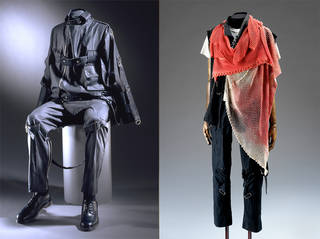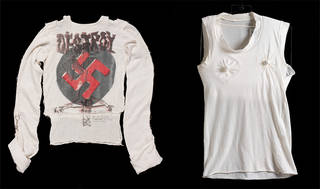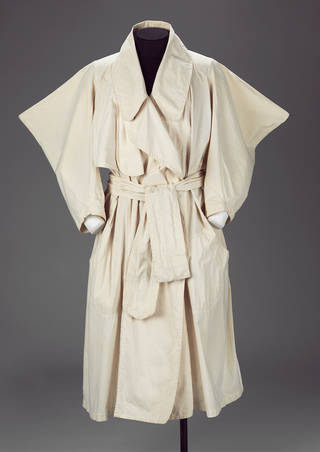Westwood will always be known for her part in the creation of punk. But in the 30-plus years that followed her split from partner and collaborator Malcolm McLaren, she forged a rebel aesthetic that was truly her own. Her trademark mix of provocation and respect for tradition is captured in key pieces in our collections, from edgy printed T-shirts to sumptuously elegant ballgowns.
I've constantly tried to provoke people into thinking afresh and for themselves, to escape their inhibitions and programming.
The punk years
Vivienne Westwood was born in a village in Derbyshire in 1941, the daughter of a factory worker and cotton weaver. She moved to London with her family as a teenager where she trained as a primary school teacher. Having split up with her first husband, it was meeting and later working with art student Malcolm McLaren (born in London in 1946) that gave Westwood a focus for her restless idealism, as well as the opportunity to harness a natural flair for dressmaking.
Rejecting the hippie ethos that was fashionable towards the end of the 1960s, Westwood and McLaren created clothes that referenced youth culture's recent past, selling rock'n'roll fashion in a shop unit at 430 King's Road in Chelsea. In 1974, the shop took on its most notorious identity: SEX, with Westwood and McLaren designing fetish wear that they sold to prostitutes, those with 'underground' sexual tastes, and young proto-punks brave enough to take a seriously edgy look out onto the street. The pair enjoyed shocking people, designing garments and shoes that referenced 'deviant' sexual practices, including rubber dresses and stilettos bristling with spikes.

In 1976, 430 King's Road was refitted and renamed Seditionaries: Clothes for Heroes. The collection remained in the same risqué territory as the clothes sold in SEX, featuring the likes of bondage trousers. A punk archetype, these trousers mix references to army combat gear, motorcyclists' leathers and fetish wear, and feature a zippered seam under the crotch, a removable 'bum flap' and 'hobble' straps that restrict movement. Other key looks that expressed a new 'distressed' form of fashion included loose-woven, 'unravelling' mohair jumpers and torn-looking dresses and tops decorated with metal chains and safety pins.

Clothes at Seditionaries were also known for their challenging graphics. The highly-charged imagery screen-printed on to frayed-looking T-shirts and muslin tops included swastikas, the Queen with a safety pin through her lips, a pair of naked breasts printed at chest height and pornographic cowboys.
Other Seditionaries T-shirt designs hint at the direction in which Westwood's tastes would develop. Her 'nippled' T-shirt uses bunched fabric as a way of clothing yet unclothing the body, demonstrating a form of provocation that is more cheeky than aggressive. Many of the items sold at Seditionaries were worn by members of the Sex Pistols (1975 – 78), the punk group McLaren had brought together to exploit what he saw as youth culture's readiness for a protest-based band.


New outsiders
The break up of the Sex Pistols and punk's rapid absorption into the mainstream left Westwood feeling disillusioned. Turning 40, and with a new interest in 'high' culture, she felt drawn to more subtle means of subverting the establishment, and began to look for different versions of an outsider aesthetic. Her and McLaren's next collection, and the first they took to the catwalk, was Pirate (Autumn/Winter 1981). With clothes that evoked what has often been described as an "age of highwaymen, dandies and buccaneers", the collection was named for its "plundering of ideas and colours from other places and periods". It featured loose-bottomed, wide-striped Bucaneer trousers, and oversized shirts worn with draped sashes. Partly inspired by Westwood's interest in silhouettes and portrait paintings of the 17th and 18th century, what became known as the 'New Romantic' look was hugely influential, and filtered quickly through to the mainstream via some of the era's leading musical acts.

Westwood relied less and less on McLaren's direct input for her next set of collections, which were all inspired by images of indigenous people she'd seen in the pages of National Geographic magazine. The most influential was Buffalo Girls/Nostalgia of Mud (Autumn/Winter 1982). Intended to demonstrate how western culture is rooted in that of various earlier societies, the collection fused Westwood's interest in historical costume with references to traditional South and North American cultures, in particular the full pleated skirts or 'polleras' and small bowler hats worn by Aymara women of the Central Andes, South America, known as Cholas or 'Cholitas'.
In an era when structured power suits were de rigueur, Westwood's collection showcased a muddy-coloured array of garments all based on a softly tailored silhouette: tattered, hip-slung dirndl skirts, woollen dresses with right-angle sleeves and raw-cut, drop-shouldered sheepskin jackets worn with crumpled felt hats. The collection was also the first to introduce underwear as outerwear, with 1950s-style satin bras worn over dresses.

After Buffalo Girls came Punkature. Launched in autumn 1982 – a period during which Westwood and McLaren split up – it featured distressed, recycled-looking 'hillbilly' garments in pre-washed and over-printed materials. Westwood described working on this show as a turning point – the first time she thought of herself as a designer, and more than "just an interpreter of Malcolm's ideas". Westwood and McLaren's last official collaboration was Witches (Autumn/Winter 1983). Sparked by images of Haitian voodoo, this collection harnessed the "magical, esoteric sign language" of New York graffiti artist Keith Haring, printing his images on boldly graphic, stretch-fabric bodies and tube skirts. It also featured oversized garments that "pushed and pulled and slightly fell off", innovatively tailored double-breasted jackets with hugely extended shoulders, and unisex cream-cotton macs with exaggerated, bat-wing sleeves.

With support from her new business partner, Italian fashion publicist Carlo D'Amario, Westwood gradually extricated herself from what had become a toxic business relationship with McLaren, and continued to produce collections. Marking Westwood's growing international reputation, her Hypnos collection (Spring/Summer 1984), made out of synthetic sports fabrics, was shown at the Best of Five global fashion awards in Tokyo. The Hypnos signature look was the bodysuit. Based on professional footballers' shirts, this cheekily provocative 'extended T-shirt' featured an exposed jockstrap, and became popular as club wear on London's gay scene.

Forwards into the past
The Mini-Crini collection (Spring/Summer 1985) marked what Westwood described as a "cardinal change" – a shift towards tailoring and "things that fitted" – and a more deliberate focus on reworking ideas taken from historical dress. The stand-out garment of Mini-Crini was Westwood's short, bell-shaped skirt – another cheekily sexual garment that combined the outline of a child's party frock with an abbreviated version of the Victorian crinoline. Other influential Westwood designs from the mid-1980s include the corsets-as-outerwear and fitted Savile jackets of Harris Tweed (Autumn/Winter 1987).
For Time Machine (Autumn/Winter 1988), Westwood made precisely constructed reworkings of styles taken from traditional English tailoring, such as the Norfolk suit (a belted jacket worn with knee breeches). This collection also featured articulated metallic jackets and corsets with removable sleeves that were inspired by medieval armour. The final collection of the 1980s, Voyage to Cythera (Autumn/Winter 1989), was a gift to the tabloid press: many of the models were skirtless, wearing thick white tights overprinted with a strategically placed metallic fig leaf.

Westwood's striking early 90s collection Cut, Slash and Pull (Spring/Summer 1991) looked to Tudor portraiture for inspiration, specifically the 16th-century practice of cutting and pricking to reveal underlying layers. In Westwood's version, it was bare skin that was exposed. Other garments included dresses of slashed voile and a decidedly modern take on the codpiece, nestled on the front of slashed silk pants trimmed with gigantic faux-fur bobbles and worn with a plunging fur-trimmed bodice and full-length gloves.

Although she was often judged 'uncommercial', Westwood remained undeterred, buoyed up by acclaim from the fashion industry, including a Womenswear Designer of the Year award from the British Fashion Council in both 1990 and 1991. Her ideas often hit the mainstream very quickly, and she had begun to make a significant amount of money from her London shops and international sales. In 1992 she was recognised by the Establishment with an OBE.
For the remainder of the 1990s, Westwood mixed teaching, new commercial relationships, and, in her couture collections, the expression of a new form of elegance – condemning what she called the 'ugly casualness' of much of contemporary fashion. She began to focus on the historical exchange of styles across the English Channel, mixing English "tailoring and easy charm" with French "solidity of design and proportion". Between 1993 and 1999 she produced several memorable reinterpretations of the past, including the clan tartans of Anglomania (Autumn/Winter 1993), the cushion bustles of Café Society (Spring/Summer 1994) and the gigantic sack-back gowns of Les Femmes ne connaissant pas toute leur coquetterie (Spring/Summer 1996), which were inspired by garments in paintings by French Rococo painter Jean-Antoine Watteau.

The age of empire
Since the beginning of the new millennium, Westwood built a hugely popular fashion brand, with shops across the globe and a number of separate fashion lines, as well as separate knitwear, accessories and perfume lines. Her work has been the subject of many major museum retrospectives (including at the V&A in 2004) and she continued to produce and show regular collections, as well as take more of a focus on activism, addressing issues including climate change, civil liberties and nuclear disarmament. In March 2016, Westwood handed over the reigns of her Gold Label line to her husband Andreas Kronthaler, who had worked alongside her for many years. They continued to design the main lines together, though the Gold Label became officially called Andreas Kronthaler for Vivienne Westwood. She became a Dame in 2006.

